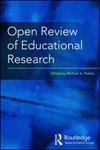Curriculum, text and forms of textuality
Q1 Arts and Humanities
引用次数: 0
Abstract
ABSTRACT Building on Peters’ and Jandrić's previous work on curriculum as ‘text’ and ‘discourse’ (Peters, M. A., & Jandrić, P. (2018b). The curious relationships between discourse, genre and curriculum. Open Review of Educational Research, 5(1).), this article seeks to refresh and extend the central metaphor of ‘curriculum as text’ that is adopted as the organizing metaphor of William Pinar’s 2006 book Understanding Curriculum: An Introduction to the Study of Historical and Contemporary Curriculum Discourses. We undertake this analysis by referring to five theoretical notions: Jorge Luis Borges’ ‘The garden of forking paths’ (1941), Roland Barthes’ structuralism (1977), Julia Kristeva's intertextuality (1966/1986), Ted Nelson's hypertextuality (1965), and Gilles Deleuze's and Felix Guattari's extratextuality (2004/1980). In conclusion, we show that the text is neither simply an artefact nor is it simply a sequence of uttered sounds. The text does not solely reside within the domain of the reader and cannot be considered as the exclusive domain of the author. Looking at relationships between text, textuality, curriculum, and technology, we show that the metaphor of ‘curriculum as text’ is inherently postdigital and that it requires development of a new postdigital language of inquiry and new postdigital forms of textual and non-textual expressions of that language in the years to come.课程、文本和文本形式
摘要基于Peters和Jandrić之前关于课程作为“文本”和“话语”的工作(Peters,M.A.,&Jandrič,P.(2018b)。话语、流派和课程之间奇怪的关系。教育研究公开评论,5(1)。),本文试图对William Pinar 2006年出版的《理解课程:历史与当代课程话语研究导论》一书中的组织隐喻“课程即文本”这一中心隐喻进行更新和扩展。我们通过参考五个理论概念进行分析:豪尔赫·路易斯·博尔赫斯的《岔路花园》(1941年)、罗兰·巴特的结构主义(1977年)、朱莉娅·克里斯特娃的互文性(1966/1986年)、泰德·纳尔逊的超文本性(1965年)以及吉勒·德勒兹和费利克斯·瓜塔里的文本外性(2004/1980年)。总之,我们表明,文本既不是简单的人工制品,也不是简单的发音序列。文本并不完全属于读者的领域,也不能被视为作者的专属领域。研究文本、文本性、课程和技术之间的关系,我们发现“课程即文本”的隐喻本质上是后数字的,它需要在未来几年发展一种新的后数字探究语言,以及该语言的文本和非文本表达的新的后数字形式。
本文章由计算机程序翻译,如有差异,请以英文原文为准。
求助全文
约1分钟内获得全文
求助全文
来源期刊

Open Review of Educational Research
EDUCATION & EDUCATIONAL RESEARCH-
CiteScore
2.60
自引率
0.00%
发文量
0
审稿时长
22 weeks
 求助内容:
求助内容: 应助结果提醒方式:
应助结果提醒方式:


